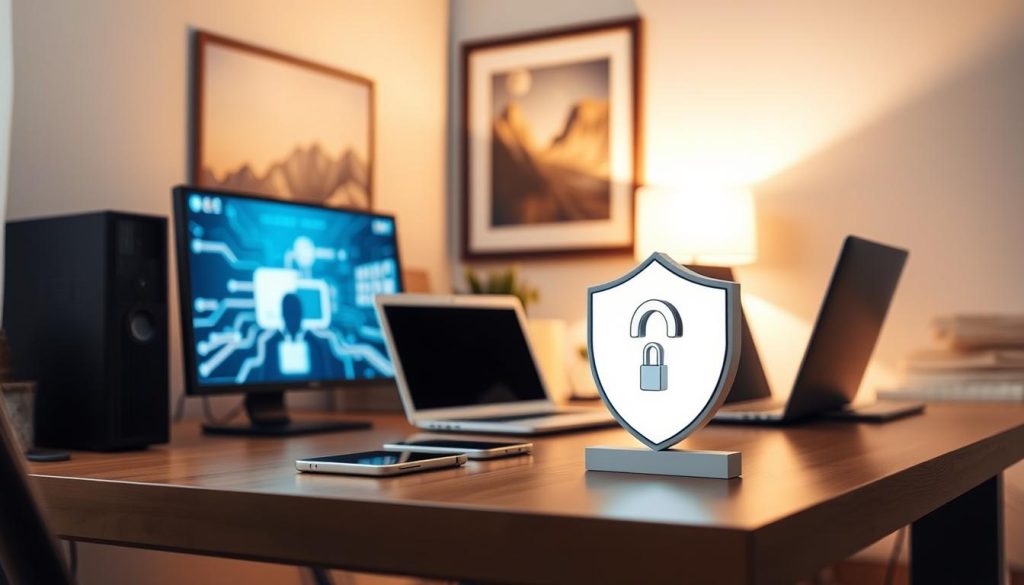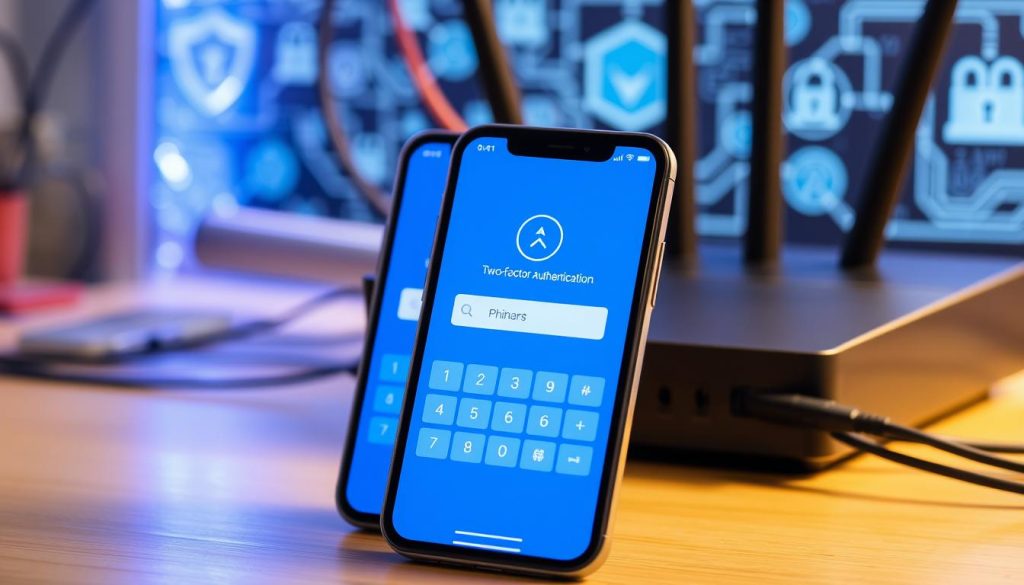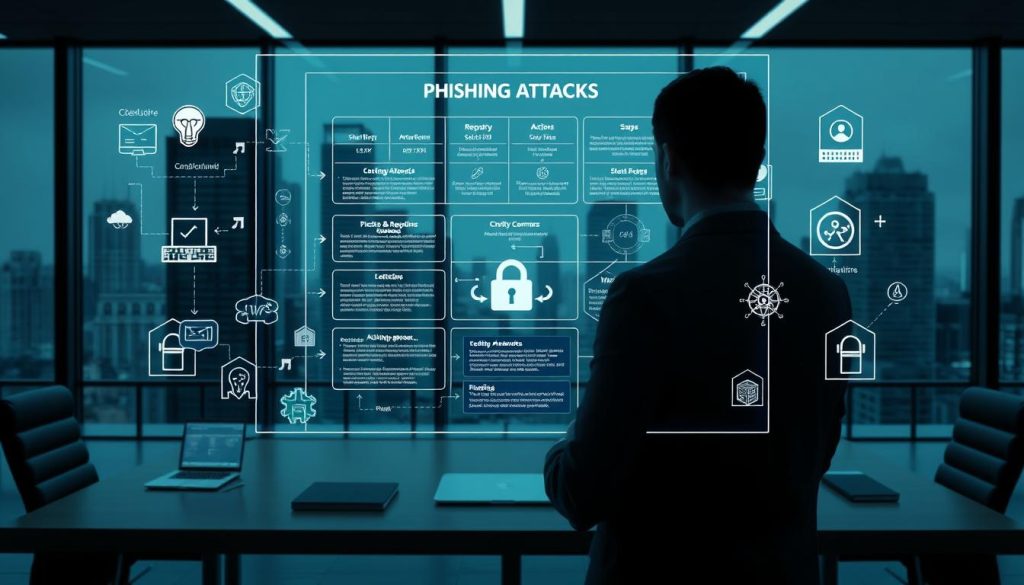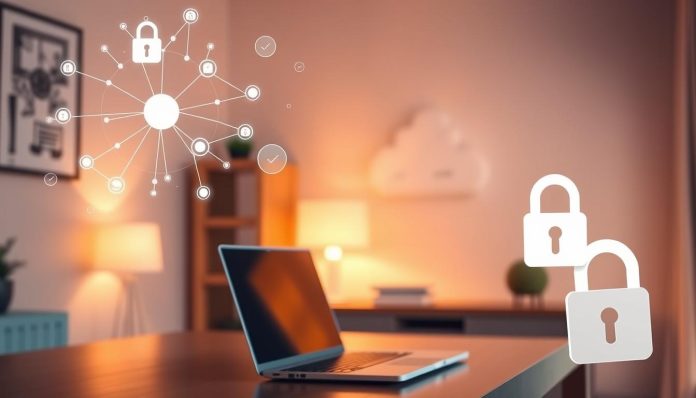Your home network is essential for everyday tasks, like banking and shopping. But, it also draws the attention of hackers. Phishing is a common trick used to steal sensitive info from unsuspecting people.
It’s important to know the types of phishing attacks to keep your home network secure. By recognizing these scams, you can lower your chances of getting caught.
Key Takeaways
- Phishing attacks can compromise your home network security.
- Understanding phishing tactics is key to protection.
- Simple measures can significantly reduce phishing risks.
- Staying informed is crucial in the fight against phishing.
- Proactive steps can safeguard your personal data.
Understanding Phishing Attacks and Their Impact
Phishing is a big threat in the world of cybercrime. It targets people and can harm home networks. Attackers use tricks to get sensitive info like login details, financial data, or personal info.
What Are Phishing Attacks?
Phishing attacks are fake messages that seem real. They can be emails, texts, or messages on social media and games. The aim is to get you to share important info or install harmful software. Phishing works because it plays on human psychology, not just tech flaws.
How Phishing Affects Home Networks
If a phishing attack succeeds, it can let attackers into your home network. They might steal your data, install malware, or demand money for it back. The damage can be huge, causing financial loss, identity theft, and personal security risks. Knowing how phishing harms home networks is key to staying safe.
Common Phishing Techniques to Be Aware Of
Phishing attackers use many tricks to fool people. Here are some common ones:
- Spear Phishing: Targeted attacks on specific individuals or organizations.
- Vishing: Phishing via voice calls.
- Smishing: Phishing through SMS or text messages.
- Pretexting: Creating a fake story to trick victims.
Knowing these tactics can help you spot and dodge phishing scams. Always be careful with emails or messages that ask for personal info or suspicious links.
Recognizing Phishing Attempts
The first step in fighting cyber threats is knowing how to spot phishing attempts. These attacks aim to trick people into sharing personal info or getting into their home networks without permission.
Signs of Phishing Emails
Phishing emails have certain traits that can help you spot them. Watch out for emails with:
- Urgent call to action or threats: Scammers try to rush you into acting without thinking.
- Spelling and bad grammar: Real emails don’t have these mistakes.
- Generic greetings: Phishing emails use general greetings, not your name.
- Mismatched email domains: Make sure the email domain matches the sender’s identity.
Fake Websites and How to Identify Them
Phishing scams often lead to fake websites that look like real ones. To spot fake sites, look for:
- URL discrepancies: Check if the URL is different from the real site’s URL.
- Lack of HTTPS: Real sites have HTTPS encryption. Stay away from sites without it.
- Poor design and functionality: Fake sites often look bad or have broken links.
Common Scams Targeting Home Users
Home users are often targeted by scams that promise amazing deals or threaten serious consequences. Common scams include:
- Tech support scams: Scammers pose as tech company reps, asking for computer access.
- Financial scams: These scams claim to be from banks or financial institutions, asking for personal info.
By knowing these signs and staying alert, you can lower your risk of falling for phishing scams. This helps keep your Internet Security at Home strong.
Safeguarding Your Home Network
Phishing attacks are getting smarter, making it key to protect your home network. You need to use many layers of security. This keeps your personal data and devices safe.
Importance of Strong Passwords
Strong, unique passwords are essential for network security. Weak passwords can be hacked easily. This lets attackers into your network and your private info.
- Use a mix of uppercase and lowercase letters, numbers, and special characters.
- Avoid using names, birthdays, or common words that are easy to guess.
- Think about using a password manager to handle complex passwords.
The Role of Firewalls in Protection
Firewalls block bad internet traffic and keep unauthorized access out. You can use both hardware and software firewalls to boost security.
Firewalls offer many benefits:
| Benefit | Description |
|---|---|
| Network Traffic Control | Firewalls stop bad incoming and outgoing traffic. |
| Protection Against Hacking | Firewalls stop unauthorized access to your network. |
| Enhanced Security | Firewalls add more security to your home network. |
Utilizing Antivirus Software Effectively
Antivirus software is key for finding and removing malware. Keep it updated and scan regularly to stay safe.
Here’s how to use antivirus software well:
- Update the software often to get the latest protection.
- Do full system scans at least once a week.
- Stay away from suspicious downloads and emails that might have malware.
It’s also important to check your account statements often. If your statement is late, call your bank right away to check on it.
Educating Family Members About Phishing
The first line of defense against phishing attacks is a well-informed family. Teaching your family about phishing dangers and how to spot threats is key. This helps prevent cyberattacks.
Importance of Cybersecurity Awareness
Cybersecurity awareness is crucial for protecting your home network. Knowing common phisher tactics helps your family avoid scams. Regular talks about online safety keep everyone cautious online.

Tips for Teaching Kids About Online Safety
Teaching kids about online safety is vital. Here are some tips:
- Explain what phishing is and how it works.
- Show how to spot suspicious emails and links.
- Tell kids to be careful with personal info online.
- Discuss the need for strong, unique passwords.
Teaching these basics helps kids develop safe online habits.
Encouraging Open Communication About Threats
Open communication about threats is essential. Make sure family members feel safe sharing suspicious activity. This way, you can act fast to prevent phishing attacks.
Regularly reviewing online safety practices as a family is also important. It keeps everyone aware of cybersecurity and phishing dangers.
Tools and Resources for Protection
It’s important to have the right tools and resources to fight phishing attacks on your home network. Using the right software and staying informed can boost your security.
Recommended Security Software
Installing reputable security software is a key step in protecting your network. Norton Antivirus and McAfee Total Protection are great options. They protect against many cyber threats, including phishing.
If you have Microsoft 365 with Advanced Threat Protection, turn on ATP Anti-phishing. It adds extra security against phishing attacks.
- Norton Antivirus: Offers real-time threat detection and protection against phishing emails and websites.
- McAfee Total Protection: Provides comprehensive security features, including anti-phishing tools.
- Microsoft 365 Advanced Threat Protection: Includes ATP Anti-phishing to help protect users from sophisticated phishing attacks.
Browser Extensions for Phishing Protection
Browser extensions are also important in blocking phishing attempts. Netcraft Extension and uBlock Origin can spot and block harmful websites.
- Netcraft Extension: Helps detect and prevent phishing attacks by analyzing website URLs.
- uBlock Origin: Blocks malicious content, including phishing sites, and provides customizable filtering options.
Online Resources for Phishing Awareness
Knowing the latest phishing tactics is key to keeping your network safe. Online resources like the Anti-Phishing Working Group (APWG) and the Federal Trade Commission (FTC) website are great for learning. They offer tips on spotting and avoiding phishing attacks.
- Anti-Phishing Working Group (APWG): Provides insights into the latest phishing trends and techniques.
- Federal Trade Commission (FTC): Offers guidance on recognizing and reporting phishing scams.
Using these tools and resources can help you better spot and block phishing attacks. This keeps your home network safe.
Implementing Two-Factor Authentication
To fight off phishing scams, think about turning on two-factor authentication for your online accounts. This extra step can really help keep your personal info and home network safe from unauthorized access.
What Is Two-Factor Authentication?
Two-factor authentication, or 2FA, is a security method that asks for two things to get into an account. It makes it really tough for hackers to get in, even if they have your password.
It usually asks for something you know (like a password) and something you have (like a phone). This makes your online world and home network way more secure.
Benefits of Two-Factor Authentication
Using two-factor authentication has many benefits for keeping your stuff safe from phishing scams and protecting your home network:
- Enhanced Security: Even if hackers get your password, 2FA stops them from getting into your account without the second thing.
- Reduced Risk of Data Breaches: Adding an extra layer of security makes it much harder for hackers to get into your accounts.
- Peace of Mind: Knowing your accounts are safe with 2FA can really boost your confidence in keeping your home network secure.
Setting Up Two-Factor Authentication on Common Services
Most online services, like email, social media, and banks, offer two-factor authentication. Here’s how to start:
- First, check if your service provider has 2FA. You can usually find this in your account or security settings.
- Then, pick your second factor. You can use SMS codes, authenticator apps, or physical tokens.
- Finally, follow the provider’s steps to set it up. This might mean scanning a QR code with an app or entering a code from a text.
By setting up two-factor authentication, you’re making a big step towards keeping your home network safe and stopping phishing scams. Make sure to turn on multifactor authentication (also known as two-step verification) on all important accounts to really boost your security.

Monitoring Your Internet Activity
To keep your home network safe, it’s key to watch your internet use. Look out for signs of trouble, use the right tools, and do security checks often.
Signs of Compromised Network Activity
Some signs your network might be at risk include unusual login locations or devices, unfamiliar programs or applications, and significant slowdowns in internet speed. Also, check your account statements for unauthorized transactions or odd activity.
Data: Check your account statements often to spot any wrong charges. This simple step can catch fraud early.
Tools for Network Monitoring
There are many tools to help you watch your network. Use network monitoring software to spot threats fast. Also, set up firewall configurations to block unwanted access.
- Network monitoring software
- Firewall configurations
- Antivirus software with network monitoring capabilities
How to Conduct Regular Security Audits
Doing regular security checks means checking your network for vulnerabilities, updating your security software, and reviewing your network settings. Make sure all devices on your network are safe and current.
To do a full security check, follow these steps:
- Update software on all devices.
- Look over your network settings and configurations.
- Run a virus scan with your antivirus software.
- Check your network logs for any odd activity.
By watching your internet use and doing security checks, you can boost your home network security. This helps protect against phishing and other cyber dangers.
Responding to Phishing Attacks
When you think you’ve been phished, it’s important to know what to do first. Acting fast can help protect your personal and financial info.
Steps to Take After a Phishing Attempt
If you’ve been to a phishing site or email, here’s what to do:
- Disconnect from the internet to stop more harm.
- Update your passwords, especially for important accounts like email and bank.
- Do a full scan with your antivirus to find and remove malware.
Keep an eye on your accounts for odd activity and tell your bank about any strange transactions.
Reporting Phishing Emails and Websites
Telling authorities about phishing scams is key to stopping them. You can report phishing emails to the FTC or your email service. For phishing sites, use Google’s Safe Browsing to report the URL.

Communicating with Financial Institutions
If you gave out financial info to a scam, call your bank or credit card company right away. They can watch your accounts, give you new cards, or protect you in other ways. If you lost money or had your identity stolen, report it to the police.
By following these steps, you can lessen the harm from a phishing attack on your home network and money safety.
Regular Updates and Patches
Securing your home network starts with keeping all devices and software up to date. Regular updates and patches are key to fixing vulnerabilities that hackers might use.
Importance of Keeping Software Up to Date
It’s crucial to keep your software current for your home network’s safety. Updates often fix security holes found after the software was first released. By updating your operating system, antivirus, and apps, you lower the risk of network breaches.
Automating Updates for Security Software
Automating updates for your security tools keeps you safe from new threats. Many security programs, like antivirus and firewalls, let you auto-update. This way, you’re always protected without having to remember to update manually.
Updating Router Firmware for Added Security
Your router’s firmware needs regular updates too. Old firmware can make your network an easy target for hackers. Check your router’s website for updates and follow their guide to update it. This simple action boosts your network’s security a lot.
By focusing on regular updates and patches, you greatly improve your home network security. This forward-thinking, along with other security steps, guards your data and devices against cyber threats.
Building a Phishing Response Plan
To fight phishing attacks, creating a detailed response plan is key. A good plan helps you act fast and well when phishing hits, keeping your network safe.
Elements of an Effective Response Plan
A solid plan should cover a few important points.
- Know the phishing threats you face, like emails or fake sites.
- Have a clear way to report phishing to the right people.
- Know what to do right away, like changing passwords and scanning for viruses.
- Keep contact info for banks and other important places handy.

Involving Family Members in Planning
Getting everyone in your family involved is key to protecting your home network. Make sure everyone knows their part in the plan, including how to spot and report phishing. This teamwork boosts your home’s security a lot.
Testing Your Response Plan Regularly
It’s important to test your plan often to make sure it works. Try out fake phishing attacks to see if your family is ready. Update the plan when new scams come up or your family changes.
By making and testing a phishing response plan, you can greatly reduce the risk of phishing scams and phishing attacks harming your home.
Staying Informed About New Threats
To keep your home network safe, it’s key to stay up-to-date on new threats. Cyber threats are always changing. So, it’s not just a one-time thing, but something you need to keep doing.
This means knowing about the latest phishing tricks, new malware types, and how hackers change their ways.
Resources for Staying Current on Cyber Threats
There are many ways to stay informed about cyber threats. Cybersecurity blogs and news websites are great places to start. They give updates on threats, tips for staying safe, and news on new cybersecurity tech.
- US-CERT (United States Computer Emergency Readiness Team)
- SANS Institute
- CyberScoop
These resources are super helpful for anyone wanting to boost their cybersecurity for home networks and stay ahead of threats.
Following Cybersecurity Blogs and News
Following top cybersecurity blogs and news outlets keeps you in the loop. They offer newsletters, podcasts, and social media updates to keep you informed.
Some top sources include:
- The Cybersecurity Podcast
- Cybersecurity News
- Dark Reading
By following these, you can learn more about internet security at home and how to protect your digital stuff.
Joining Online Communities for Knowledge Sharing
Joining online communities about cybersecurity is a great way to share and learn. You can find these on social media, forums, and special websites.
Being part of these groups helps you:
- Learn about new threats and how to fight them.
- Share your own tips and experiences.
- Keep up with the latest in cybersecurity.
By getting involved, you can get better at spotting phishing emails and other threats. This makes your home network safer.
Conclusion: Staying Safe from Phishing Attacks
Phishing attacks on home networks can cause a lot of harm. The key to safety is knowing what to watch out for. By learning about attackers’ tricks and taking steps to protect your network, you can lower your risk.
Key Takeaways for Home Network Security
To keep your home network safe, use strong passwords and firewalls. Also, install antivirus software and enable two-factor authentication. Keep your software up to date and be careful with emails and websites.
Remaining Vigilant Against Phishing Attacks
Stay updated on new threats and talk to your family about online safety. This helps keep your network safe. By being alert and taking the right steps, you can protect your home network.
Final Thoughts on Protecting Your Home Network
Keeping your home network safe from phishing attacks needs constant effort. By following the tips in this article, you can keep your network secure. This ensures a safe online space for you and your family.

